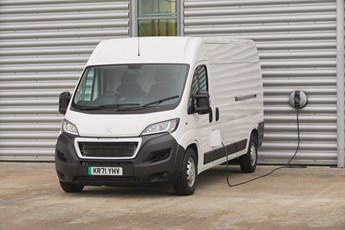- Medisort electrifying van fleet with Bedeo
- ADVERTISEMENT FEATURE: Taking a shortcut to reduce commercial vehicle emissions
- The What Van? Road Test: Ford Ranger Raptor
- Speakers announced for Commercial Vehicle Show
- Check new vehicle registration details are correct, AFP tells fleets
- New Market Analysis: Large Vans
- Increasing proportion of leased vehicles now LCVs, BVRLA reports
- Enterprise announces commercial vehicle technician recruitment programme
- The Green Insurer enters van insurance market
- Isuzu D-Max long-term test – Latest Report
Peugeot e-Boxer (2021) review
Date: Tuesday, April 5, 2022

|
|
Having kicked off its electric van range with the medium e-Expert, Peugeot has now completed its battery-powered line up with the compact e-Partner, and the van tested here, the large e-Boxer (an identical model is also available from fellow Stellantis brand Citroen as the e-Relay, with Vauxhall’s Movano-e being closely related as well).
The e-Boxer comes with a choice of two battery sizes: a 37kWh, or the larger 70kWh that we tested, which achieves a 139-mile range between charges in official WLTP testing. It can be recharged to 80% capacity in one hour using a 50kW DC charger, or alternatively a 100% charge with a 22kW or 7.4kW wallbox, taking nine and 12 hours respectively.
The e-Boxer is available with a choice of three vehicle lengths, and as either a panel van or a window van. The location of the van’s battery under the floor of the vehicle means there is no reduction in the size of the load space compared with a diesel Boxer – although the weight of the battery with the specifications tested here means a reduced gross payload.
An electric motor output of 120hp might not sound like much for a large van – and is a surprise given that smaller Stellantis vans come with more powerful motors – but in the urban areas where we would expect the e-Boxer to spend most of its time it performs reasonably well. The quick response to throttle inputs you get with an EV is particularly useful, for instance when pulling out of junctions, and having no gear changes to worry about means a straightforward driving experience – although having a manual handbrake with an electric powertrain is an unusual combination that could make hill starts potentially tricky.
Moving out of town also makes things less impressive. At A-road speeds, quite a heavy right foot is needed to accelerate. Similarly, the e-Boxer struggles to maintain cruising speed when going uphill on a motorway, (even with an empty load bay for our test). With this in mind, operators will be best off sticking to urban routes.
Rather than the silent driving experience you might expect with the e-Boxer, there is a sort of electric whining noise, but it is still far quieter than a diesel van would be. Handling is trouble free, with no difficulties placing the van on the road, and we will attribute a slightly jiggly ride while testing to that empty load bay, though there are no harsh edges, with bumps in the road comfortably absorbed.
Disappointingly, given the model’s asking price, the Boxer’s conversion into an electric van does feature some rather low-rent cabin elements. For instance, instead of a dedicated EV instrument panel, you just get the regular cluster from the diesel version, but with the needles removed from all the dials except the speedometer. And while the regular heater/ventilation controls remain in place on the centre console, setting the air conditioning temperature requires operating a separate digital display mounted to the right of the steering wheel. A smarter feature is the central rear-view mirror, which is repurposed to display battery charge information via a computerised display – although we are not sure why this display is not sized to take up the whole of the mirror.
The e-Boxer is only offered with the Professional trim level, the mid-range option of the regular Boxer range. Equipment with this includes rear parking sensors, the aforementioned air conditioning, and a 5in touchscreen with satnav, though the latter is not the quickest system to boot up or respond to touches.
In terms of price, power, and electric range, the e-Boxer stacks up reasonably well against most electric large van rivals currently on the market. However, they all have a potential problem with the new Ford E-Transit, which offers more power, a cheaper price, and also a greater driving range according to Ford’s provisional figures.
Peugeot e-Boxer Van Professional L3 H2 435 Electric 70kW Auto
Price (ex VAT, inc PiVG) £57,035
Price range (ex VAT, inc PiVG) £51,285-£60,700
Insurance group tbc
Warranty 3yrs/100,000mls (battery 8yrs/100,000mls for 70% of capacity)
Service intervals 1yr/12,500mls
Load length 3,705mm
Load width (min/max) 1,422/1,870mm
Load bay height 1,932mm
Gross payload 740kg
Load volume 13m3
Engine size/power 120hp electric motor
Range (WLTP) 139mls
CO2 0g/km
VerdictWell suited to urban operations, but cheap-looking interior conversion takes the shine off. |
7/10 |
|||
View The WhatVan Digital Edition


